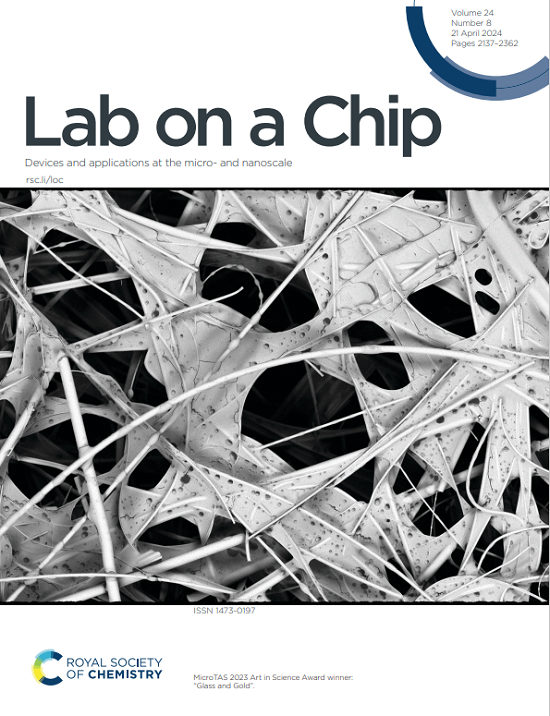Droplet-based cell viability assay for analysis of spheroid formation, proliferation and high-resolution IC50 profiling
IF 5.4
2区 工程技术
Q1 BIOCHEMICAL RESEARCH METHODS
引用次数: 0
Abstract
Three-dimensional (3D) cell cultures or samples generated from biopsies are typically used as patient-specific in vitro models. As 3D cell cultures form cell–cell and cell–matrix interactions and mimic the in vivo situation better compared to monolayer cultures, they provide more reliable data for drug screening applications. In the field of drug screening, microfluidics is moving to the forefront for testing the efficacy of drugs, as measured by IC50 values. Droplet-based microfluidics not only shares the advantages of well plate-based systems but also those that go beyond. The high-throughput character of droplet-based microfluidics enables the generation of hundreds of droplets per minute, with smaller volumes than in well plate-based systems. The high level of automation and the closed character of such systems permit a higher reproducibility of the generated data, as the well-known problem of evaporation in well plates is negligible. In this study, a modular droplet-based microfluidic platform is introduced that facilitates the formation of 3D cell cultures. For assessing cell viability in spheroids of the human embryonic kidney cell line, HEK-293, a resazurin-based CellTiter-Blue® assay was established on a droplet-based platform. Here, the pipe based bioreactors (pbb) technology was used to create a continuous drug gradient, enabling the realisation of 290 concentration levels within a single droplet sequence to determine high-resolution IC50 values. Consequently, the pbb technology exceeds the state of the art, as only discrete concentrations of drugs are investigated in well plate-based systems. DMSO was used for drug testing experiments, as drugs are typically dissolved in it. As it is important that healthy cells are not affected by the drug or its solvents, the influence of DMSO was examined. Overall, the presented platform not only offers a robust and precise tool for validating drug efficacy using 3D cell cultures but also provides the basis for developing innovative therapies across a wide range of diseases. The modular design of the pbb platform provides the flexibility to address a variety of biomedical applications, ultimately accelerating personalized medicine to deliver better outcomes for patients.

基于液滴的细胞活力测定用于分析球体形成,增殖和高分辨率IC50谱
三维(3D)细胞培养物或活检产生的样本通常用作患者特异性体外模型。由于3D细胞培养物形成细胞-细胞和细胞-基质相互作用,并且与单层培养物相比能更好地模拟体内情况,因此它们为药物筛选应用提供了更可靠的数据。在药物筛选领域,微流体技术正走向测试药物功效的前沿,以IC50值为衡量标准。基于液滴的微流体不仅具有基于井板系统的优点,而且还超越了基于井板系统的优点。基于液滴的微流体的高通量特性使得每分钟能够产生数百个液滴,体积比基于井板的系统小。由于众所周知的井板蒸发问题可以忽略不计,这种系统的高度自动化和封闭性使得生成的数据具有更高的再现性。在本研究中,引入了一种模块化的基于液滴的微流控平台,促进了三维细胞培养的形成。为了评估人胚胎肾细胞系HEK-293球体中的细胞活力,在基于液滴的平台上建立了基于reazurin的CellTiter-Blue®检测方法。在这里,基于管道的生物反应器(pbb)技术被用于创建连续的药物梯度,从而在单个液滴序列中实现290个浓度水平,以确定高分辨率的IC50值。因此,pbb技术超越了目前的技术水平,因为在基于孔板的系统中只研究离散浓度的药物。DMSO被用于药物测试实验,因为药物通常溶解在其中。由于重要的是健康细胞不受药物或其溶剂的影响,因此研究了DMSO的影响。总体而言,该平台不仅为使用3D细胞培养验证药物疗效提供了强大而精确的工具,而且还为开发跨多种疾病的创新疗法提供了基础。pbb平台的模块化设计提供了解决各种生物医学应用的灵活性,最终加速个性化医疗,为患者提供更好的结果。
本文章由计算机程序翻译,如有差异,请以英文原文为准。
求助全文
约1分钟内获得全文
求助全文
来源期刊

Lab on a Chip
工程技术-化学综合
CiteScore
11.10
自引率
8.20%
发文量
434
审稿时长
2.6 months
期刊介绍:
Lab on a Chip is the premiere journal that publishes cutting-edge research in the field of miniaturization. By their very nature, microfluidic/nanofluidic/miniaturized systems are at the intersection of disciplines, spanning fundamental research to high-end application, which is reflected by the broad readership of the journal. Lab on a Chip publishes two types of papers on original research: full-length research papers and communications. Papers should demonstrate innovations, which can come from technical advancements or applications addressing pressing needs in globally important areas. The journal also publishes Comments, Reviews, and Perspectives.
 求助内容:
求助内容: 应助结果提醒方式:
应助结果提醒方式:


